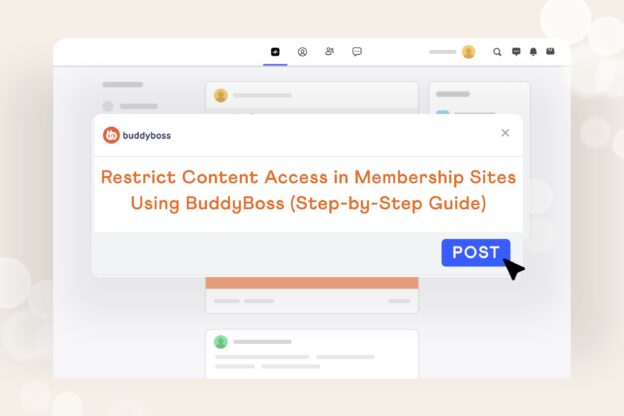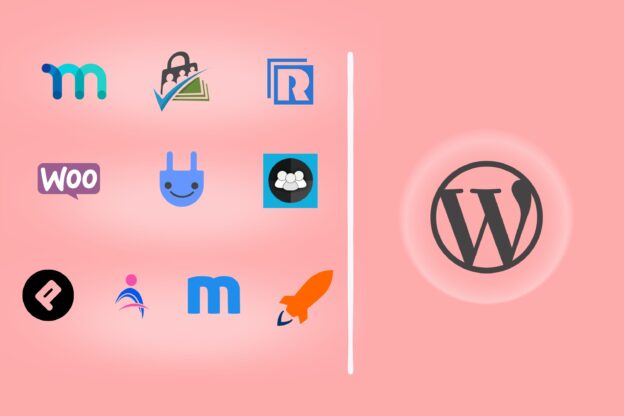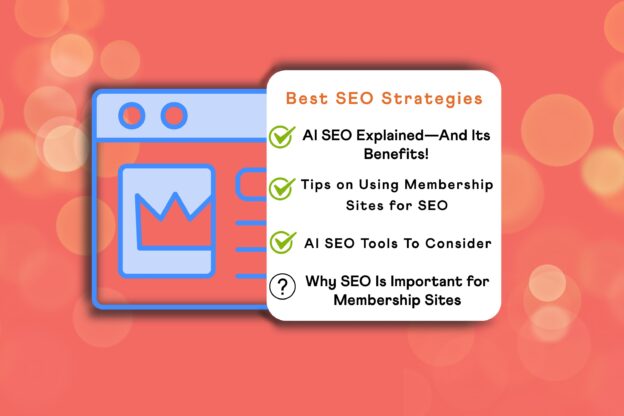If you are interested in building a membership site, you might be (probably are) concerned about the cost.
You can see the potential income in building a membership site but aren’t quite sure about the initial costs.
And what about the ongoing costs of running the site?
We can’t tell you the exact number your site will cost – exact costs will obviously vary on many project-specific factors.
We can, however, give you an understanding of what you should expect to spend money on when building and running your membership site.
High Level Overview

The first things you will need to consider are a domain name and hosting. The hosting is essentially where your website lives.
The domain is the address that directs people to it.
Next, you will need to build your website – and for a membership site, you will need a content management system like WordPress.
You will then need a design for your website and to have that design implemented by a developer.
With most CMSs, you will need to implement additional functionality to create a membership site.
The primary functionality is the ability to restrict access from non-members but allows access for members. You will also need a way to accept payments.
There will be further running costs, such as marketing, to consider once you build the site.
With almost every aspect of building a membership site, there will be a relatively cheap option and a more expensive option.
In most cases though, there will be a reason why it’s cheap, and a reason why the higher-priced option may be the better choice.
Domains

Domains are a relatively cheap place to start. More obscure domain extensions like .club or .xyz can often be purchased for a few dollars per year. A .com domain is generally more expensive, at around $10 per year.
Domains can get expensive should they already be taken.
In 2009, Insure.com was bought for $16 million. Hopefully you have a more original, and therefore available, domain in mind.
Expected cost – $10 p/y
Hosting

Costs of hosting vary hugely. The cheapest type of hosting, shared hosting, can cost as little as a few dollars per month. It is even possible to host a website for free, but with certain limitations.
These options will eventually prove insufficient as your business scales. Shared hosting means that your website would share space with many other websites. If they use up a lot of bandwidth, that means less bandwidth available for your site. If they are infected with malware, your site could be vulnerable.
Dedicated hosting solutions mean that your website will have its own server. You would have complete control of its configuration, all of the bandwidth, and no nuisance neighbors to share with. This could easily cost hundreds or even thousands of dollars per month though. Virtual private servers are the middle-ground option.
If you’re starting out, shared hosting would make sense. Be prepared to upgrade in the future to handle the increased traffic a popular membership site could demand.
Expected cost – $5 p/m to $100 p/m
Content Management System (CMS)

A content management system is an application that you can install in your hosting that will allow you to publish content to your website. A CMS comes with a back-end interface which allows you to control what displays on the public facing website (the front-end).
Fortunately, the base cost of the most popular CMSs is nothing. This isn’t a case of WordPress, Drupal or Joomla being inferior CMSs, rather that you will undoubtedly want to extend the core product.
WordPress is a popular choice due to the amount of options you have to extend the platform. WordPress actually lacks the functionality to be a membership site. Upon installing WordPress, you have the choice of a few fairly plain themes which control the design. It does little more than allow you to create some blog posts and pages. But thanks to tens of thousands of themes and plugins, you can easily change that.
You may want functionality in addition to the membership plugin and payment processor. BuddyPress is a popular social media plugin which will allow your users to chat, create profiles and user groups. BbPress is another popular plugin which would allow you to create a forum on your membership site. Both of those plugins are free, open source and very popular in the WordPress community.
Depending on your aims for your membership site, you may require other functionality which might not be free. Thanks to the generosity of developers and their commitment to open source software, there are often free plugins to help you. The advantage of premium plugins is generally the ongoing support offered.
Expected cost $0 – $250 p/y
Cloud Based Membership platforms
Alternatively, you could combine your hosting, CMS and domain name into a single package. These are often referred to as Software as a Service (Saas) or cloud based systems. The big difference between these services and installing your own CMS onto your own hosting service is, well, ownership.
With a lack of ownership, there is a lack of control. The cloud based platforms’ monthly costs will often exceed the cost of a self-hosted site. So why use these types of services? Because they are easy to set up, and often the quickest route to market. That monthly fee will usually include support.
Expected cost $50 p/m
Design

Design is more than purely aesthetics. A well designed site is one where a user can achieve their goals. If 100 people attempt to sign up on your website, but 20 of them don’t understand how to register, then you’ve lost 20% of your potential income. If your site is well designed, that potentially lost revenue can be minimised.
Your most expensive option is to hire a professional designer or design agency. These costs could easily run into thousands of pounds. A cheaper option is to buy a premade theme. A well-made WordPress theme will generally cost between $40 and $80.
There are also free options available. These themes won’t give your site a unique look, but might be a more affordable option when starting out. Bear in mind that poor design will hit your bottom line. If you are able to invest in a professional, it will save you money in the long run.
Expected cost $40 – $3000
Development
If you choose to have your site designed by a professional, you will need to have that design converted into a website. A professional developer, or development agency, will take your site’s design files and turn it into a website using code. Developers can also implement the functionality that makes your site a membership site.
Developers that build sites with code and specialise in membership sites will cost thousands of dollars. The advantage of this approach is that websites will be tailor made. You can specify the exact design and back-end options you want created for you. Sites created by professional developers will also be optimised for speed and more secure.
A cheaper option may be a developer that would adapt a pre-existing theme to your design. Some developers in the WordPress space use premium themes or page builders to create websites. These make building websites possible without using code.
Page builders are designed to be accessible to all. If you have the patience and time available, you could put together a passable website yourself. There will be limitations on what can be created with a page builder. They also have an impact on your website’s speed, but they may be a good option for someone keen to do it themselves.
Poorly built sites can run slow, with page builders being just one aspect that can slow your site down. The slower your site, the less potential customers you will convert. Websites lose 1% of their visitors for every extra 100 milliseconds of page load. At 3 seconds of loading time, 53% of your visitors will abandon the site.
Just like with design, investing in a professional developer or agency will pay off in the long run.
Expected cost $0 – $3000
On-going costs
We’ve completed the costs of building your site, but this won’t be the end of your expenditure. A membership site comes with running costs. Again, this will vary pretty significantly based on the purpose of your site, but we’ve picked out a couple most membership sites will need.
Email marketing
You’ve built your site, but no one will visit if you don’t tell them about it. There are a ton of ways to promote your site, but one form of marketing you are likely to make use of is email marketing.
Email marketing is a great way to promote your offers to people who have registered an interest in your product. It is also a great way to retain existing members. When you post new content on your site, send out an email to all your members letting them know. If you invest time and money into creating new material but your members never know about it, they might lose interest.
MailChimp is a well known service in the email marketing space. It’s particularly well known because it offers a free version of its service that allows you to send up to 12,000 emails per month. A more advanced email marketing service is Infusionsoft by Keap. Infusionsoft goes beyond mere email marketing, allowing you to create a complete marketing funnel.
Here is a helpful list of email marketing software you might want to look at.
Expected cost $0 – $300 p/m
Video Hosting

For most other types of website, video hosting can be as simple as linking to YouTube. On a membership site, that’s inadequate. The problem is that you can’t restrict people from viewing your videos on a standard YouTube account. It will be easy to access your content without becoming a member.
You can restrict your content with a premium video hosting service. With a service like Wistia or Vimeo, you will be able to ensure only your members see your content. You’ll also have full control over your videos, with no adverts and no possibility for a competitor’s video to play after yours..
$20 – $99 p/m
Payment Processor
To accept payments for memberships to your site, you’ll need a payment processor. You’ll probably end up using either one of, or both of, Stripe and PayPal. The base fees are the same for both: 2.9% of each transaction plus $0.30. PayPal has a few extra service fees that might make you want to push your customers towards Stripe. PayPay does have a long history and a big reputation, however. You wouldn’t want to lose customers that are more comfortable paying via PayPal over a slightly higher fee on American Express cards.
Expected costs 2.9% + $0.30
As you can see from the above sections, the costs of a membership site can vary wildly. As such it would be misleading to calculate a total from the minimum costs, as almost no one will ever spend the minimum amount.
The main take away from the article is all the costs you will have to account for when building a membership site. It should help you understand how cheap it can be to get started. It will also highlight areas where you can invest in the future to improve your offering. Hopefully, this addresses any of your concerns about cost and will give you the confidence to make your site a reality.
Now, BuddyBoss – of course – can handle all of these steps for you. Over many years in the WordPress development business, we’ve built numerous communities and streamlined our costs to bring you the most affordable solutions. Whether you need full development from the ground up, or just assistance with customization, design, or some other aspect, we can help.












